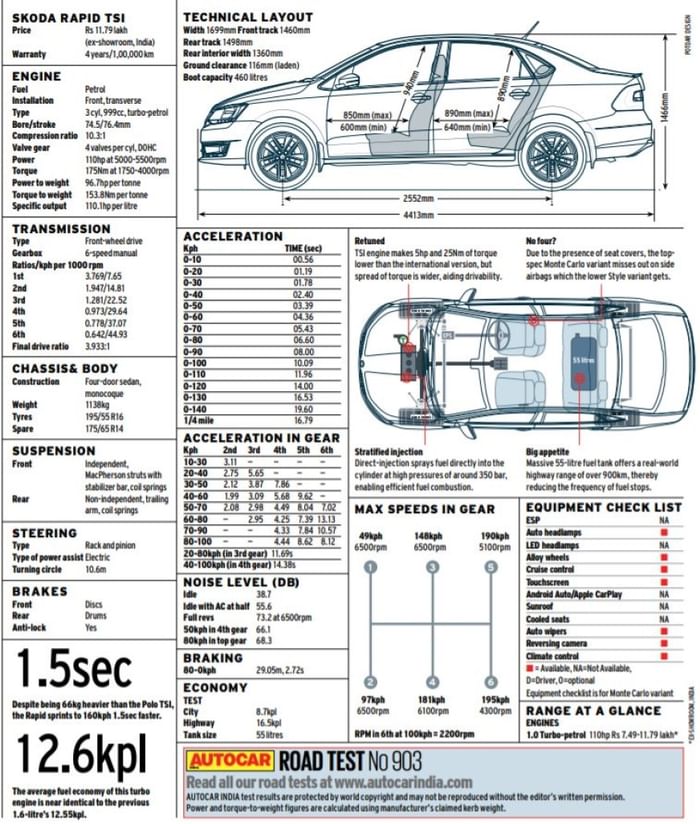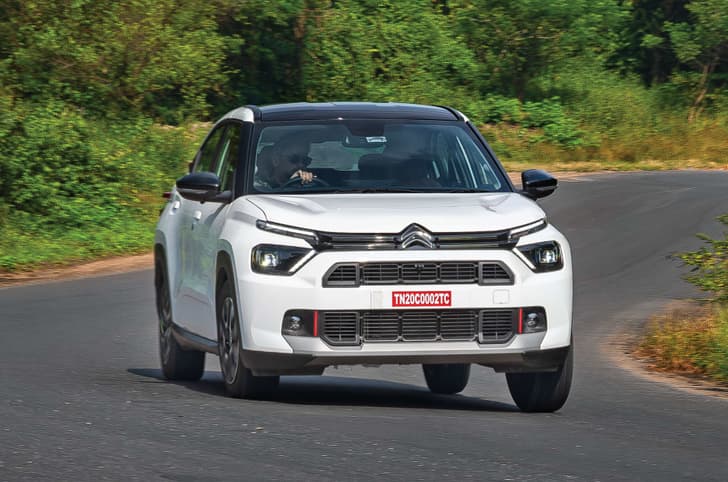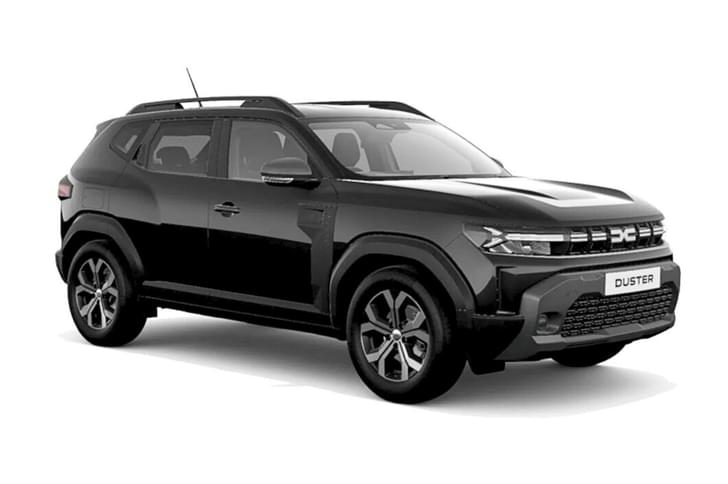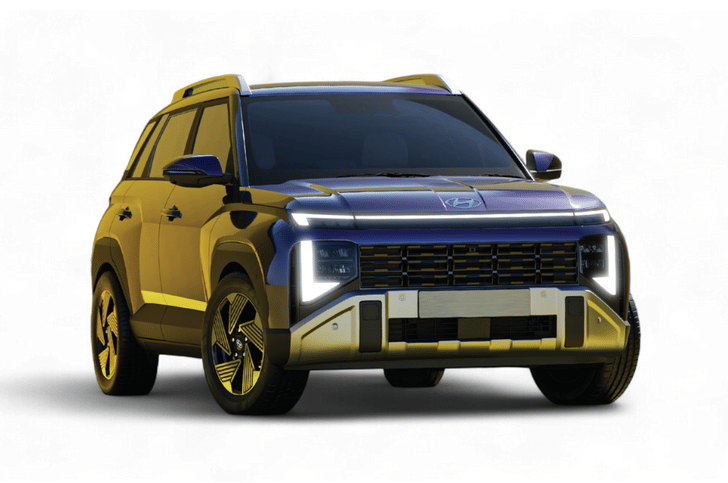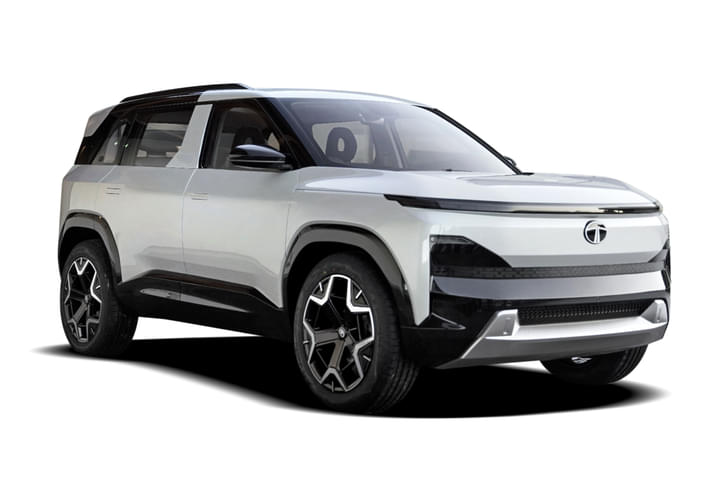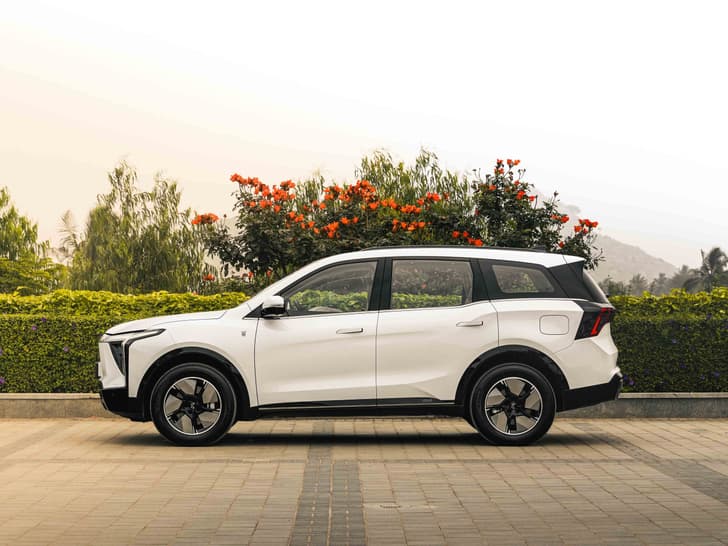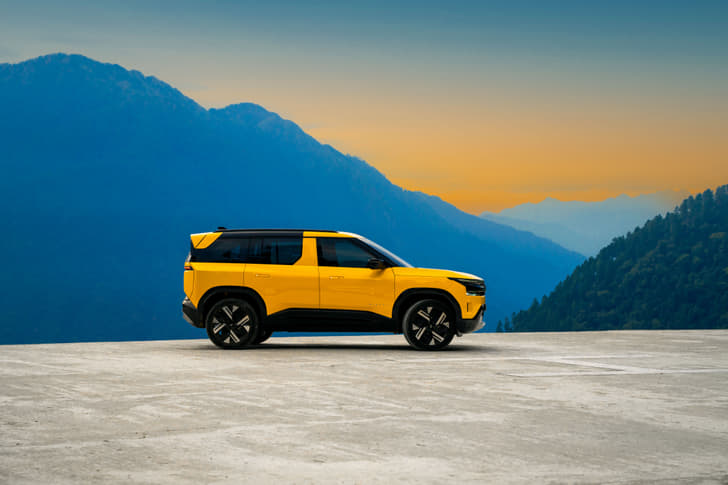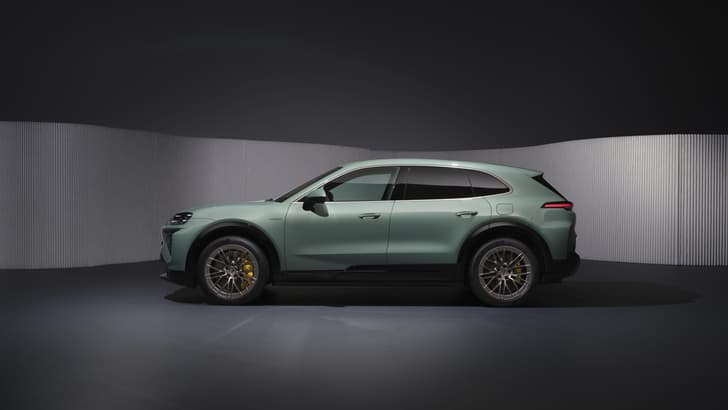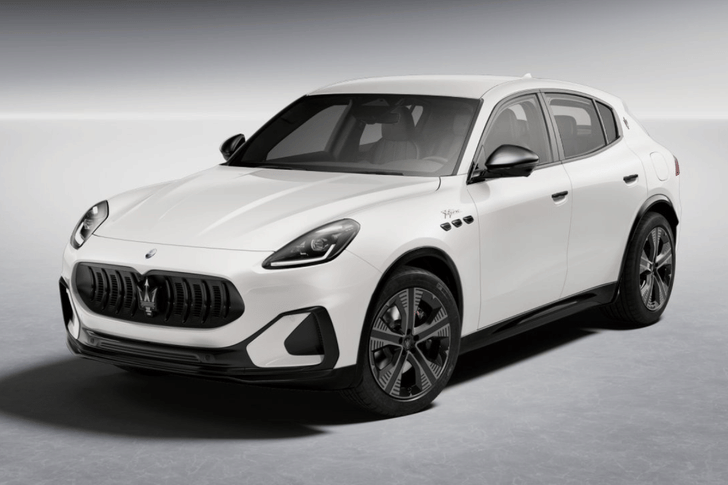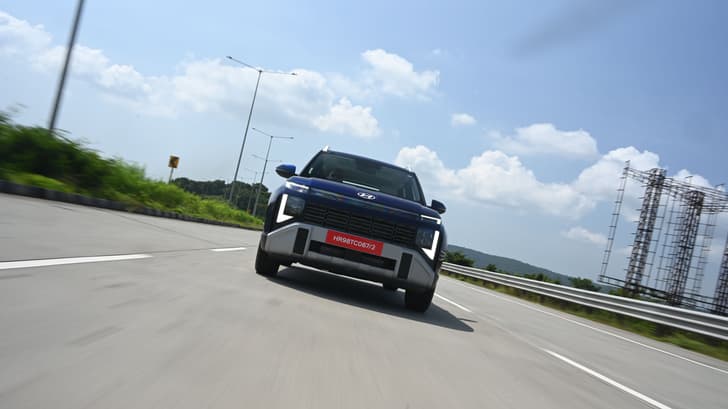An outcome of a strategic badge engineering exercise between Volkswagen and Skoda back in 2011, the Rapid quickly established itself as a solid, practical midsize sedan that was nice to drive and came with quality interiors. But while the competition underwent generation changes that ensued over the years, the Rapid got a cosmetic makeover in 2016, which has been carried forward on this 2020 version as well. Still, the Rapid soldiered along, despite the competition, thanks to the ace up its sleeve – its strong diesel engine. Now, with new emission norms coming into play, the older petrol and diesel engines have made way for a leaner and a more modern 1.0-litre turbo-petrol engine and a new 6-speed manual transmission (the sole configuration on offer); an automatic will join the range in a few months. How does this small engine perform in this midsize sedan? Can it match up to its competitors with large displacement engines? We put it through our full-blown test to find out.
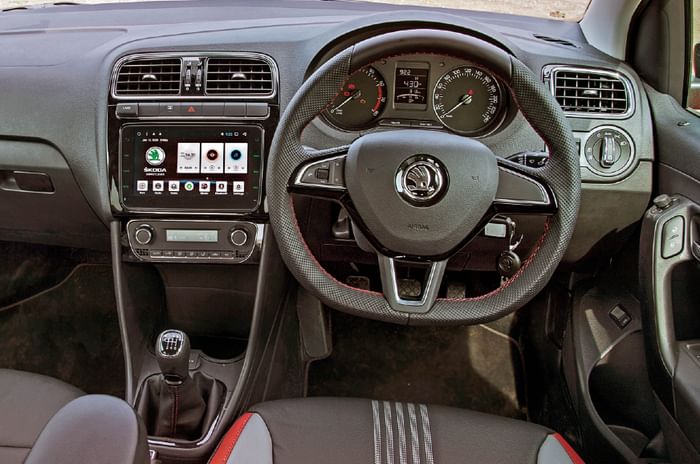
Bearing minimal styling elements and an uncluttered design, the 2020 Rapid looks identical to the previous version, but it has aged so well, it still appears relatively fresh and modern. Like the exteriors, the interiors remain unchanged too, with a neat layout, boasting a solid build and some high quality materials. The minimalistic styling appears a bit drab compared to more modern rivals, but the black theme and red accents of this Monte Carlo variant livens things up a bit. The flat-bottomed steering wrapped in perforated leather looks racy and feels superb to hold. Other new inclusions are the seat upholstery and the 8.0-inch infotainment system, both of which look like aftermarket accessories (more on the infotainment’s functioning in a bit). Seat comfort is very good. The Rapid, however, isn’t as roomy as the Honda City or the Maruti Ciaz, and a third passenger at the rear will feel unwelcome due to the seat’s narrow width and large central tunnel; the latter isn’t a transmission tunnel, contrary to common perception, it is an element which adds torsional rigidity to the structure.
Codenamed EA211, this 999cc, threecylinder turbocharged petrol engine is an internationally acclaimed motor known for its healthy amount of performance. It gets direct injection, so it comes with a set of merits, wherein a precise amount of fuel is sprayed into the cylinder directly at pressures as high as 350 bar (very high for a petrol engine), enabling efficient combustion. What’s more is this motor leaves low amounts of residue like CO2 and NOx, making it comply with the most stringent global emission standards of today.
Shared with the Volkswagen Polo and Vento, this 1.0-litre TSI motor makes 110hp and 175Nm of torque; so the Rapid gains 5hp and 22Nm over the previous EA111 1.6-litre petrol engine, thanks to forced induction. The power and torque figures have been reworked for India, compared to the international version’s 115hp/200Nm. However, max torque is available between 1,750-4,000rpm, a much broader spread than the international Rapid’s 2,000-3,500rpm.
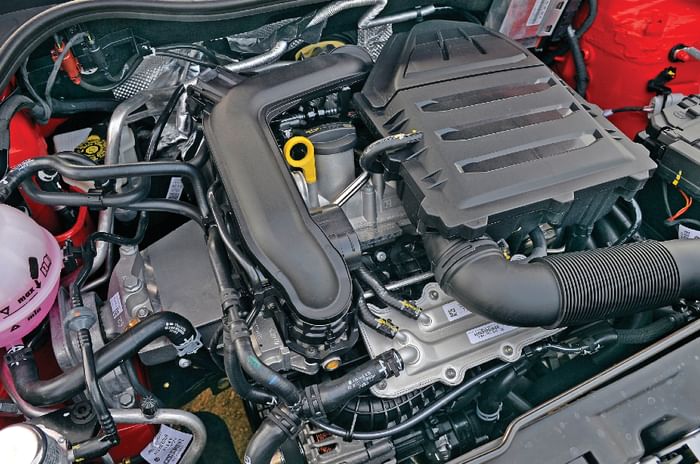
The nice and wide spread of torque is immediately noticeable, as well as the well-judged gear ratios that make it an effortless motor. There is some perceptible lag below 2,000rpm, but get past that and power flows in a strong yet linear manner. And those who enjoy driving will love the engine’s rev-happy character which eggs you to spin it closer to its 6,500rpm rev limiter without feeling strained.
Get caught off-boost and you will have to downshift to bypass the turbo lag and get moving again. Consider acceleration from 30-60kph in third or 50-80kph in fourth gear, simulating scenarios of closing a traffic gap or making a quick overtake, and the little TSI sprints in a respectable 5.35sec and 6.60sec, which is much quicker than the new-generation Honda City (6.43sec and 8.80sec) and the Maruti Ciaz (5.26sec and 7.60sec), both of which are powered by larger 1.5-litre petrol engines. On-tap responses, or that initial bit of response at lower RPMs of large displacement engines still remains unbeaten by this smaller capacity turbo unit, but get past that slight initial delay, and this force-fed motor comes into its own due to its torquier character.
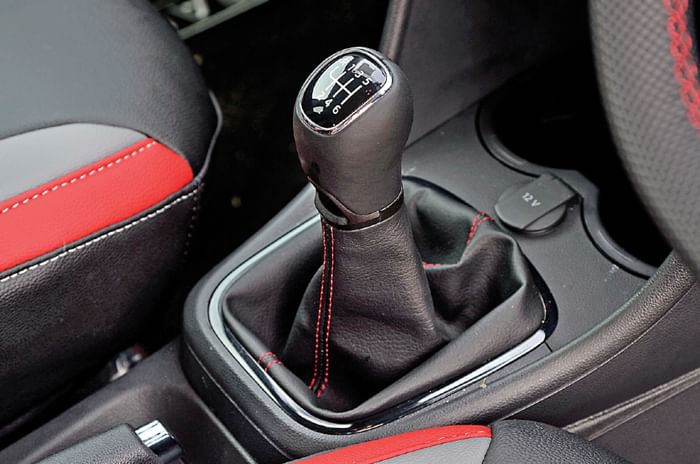
Where this small-capacity engine really shines is in outright performance. Outrunning the new-gen Honda City by 1.6sec in the sprint to 160kph, and the TSI will even go on to max out at a top speed of 195kph, living up to its Rapid name.
This engine is largely refined, and it is only at idle that you feel mild vibrations as it rocks on its mounts. Sound insulation is terrific, and it masks speeds like a much more expensive car. It does get thrummy at higher revs – a typical three-cylinder characteristic – but it is never too loud or intrusive.
The 6-speed manual is light to use, although it can feel a bit notchy at times, and while the clutch is light, its travel is a bit long. So, overall, it isn’t as easy to drive as its Japanese or Korean rivals.
Turbo-petrols have a tendency to be extremely frugal when driven at steady speeds, and this TSI motor is no different. In our tests, it delivered 16.5kpl on the highway, a 1.4kpl improvement over the older 5-speed, 1.6-litre unit. Helping its case further is its taller gearing and three overdrive gears, which make it an easy sipper while cruising; as an example, at 100kph, it spins at a lazy 2,200rpm in sixth gear, consuming less fuel. On the other hand, at low speeds and in traffic conditions with constant on-off boost driving, fuel efficiency takes a hit, resulting in a poor 8.7kpl in the city, 0.7kpl lower than the old 1.6-litre. This doesn’t come across as a surprise as it is still a 1.0-litre engine lugging 1,138kg of the Rapid; and when the turbo isn’t fully singing, you will need to accelerate harder to squeeze out every bit of performance to get moving, thus resulting in higher fuel consumption.
The Rapid remains mechanically unchanged, and if anything, it feels even better with this TSI engine. Ride comfort is still impressive, and it smoothens out road imperfections and takes most road shocks in its stride. Only the sharper potholes filter through to the cabin, accompanied by a mechanical thunk from the suspension owing to its stiff damping. What’s nice is that the Rapid doesn’t rock side by side on uneven roads, but it still does pitch a bit over wavy roads. The Rapid remains stable at highway speeds and it masks speeds like a much more premium offering.
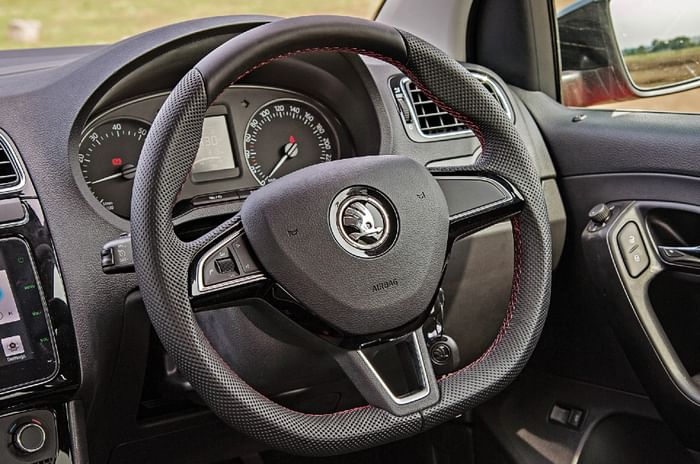
With a taut chassis, tight body control, and less nose-heaviness than before, the handling feels a lot more balanced and agile now. And although not bristling with feel, the steering offers some reassuring heft, and, as a result, is sharper to turn-in and is confidence-inspiring.
The top-spec Monte Carlo variant is equipped with a tilt and telescopic steering, auto headlamps and wipers, cruise control, 16-inch alloys, tinted windows, auto-dimming mirror, electric folding mirrors and a reversing camera. Skoda has added a new Android-based 8.0-inch touchscreen system loaded with multiple apps (usable via your smartphone’s Wi-Fi), and it also supports phone mirroring via a third-party app. While the resolution is crisp, the interface isn’t very slick or intuitive, and most users will miss the sheer simplicity of Android Auto and Apple CarPlay, both of which are conspicuously missing.
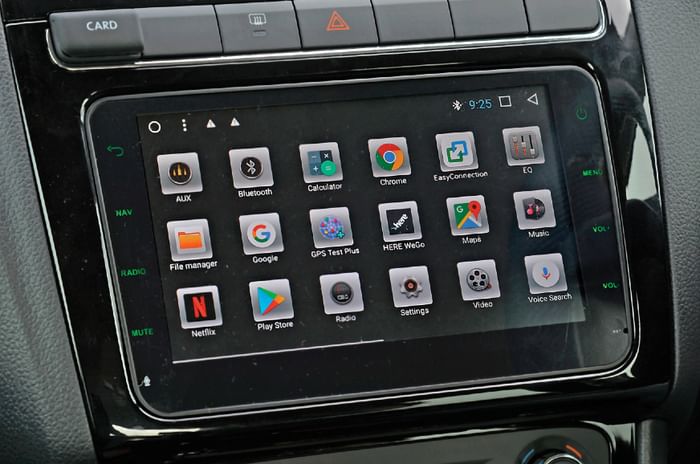
The lower-spec Style variant gets side airbags (missing on the Monte Carlo due to the seat covers it gets). Overall, the competition is better equipped with features like a sunroof, LED headlamps, wireless charging, cooled seats, ESP, side and curtain airbags and a tyre pressure monitor, all of which are missing from the Rapid’s list.
The Rapid has always been a fundamentally strong proposition, and this new engine only makes it better. Performance has significantly improved compared to the earlier 1.6-litre, and it still remains one of the nicer cars to drive in its class. It retains that solid, reassuring build, and the interior quality is second to none. At Rs 7.49 lakh (base Rider variant), Skoda is offering this mechanically sound, three-box sedan for the price of a premium hatchback, making this variant incredible value for money. However, the Rider trim aside, the Rapid’s value proposition fades away when you look at it in a broader light, amidst its competitors. Its city fuel economy is a bit low; it misses equipment like a sunroof, LED headlamps and Android Auto or Apple CarPlay; and the interior’s styling seems quite dated by modern standards.
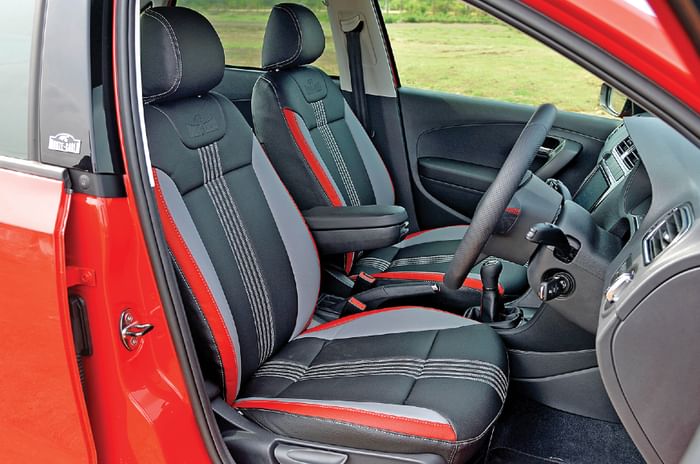
But despite its flaws, the Rapid’s appeal lies in its simplicity and in the way it drives, and if you are willing to compromise on some features and a bit of modernity for a solid driving experience, the Skoda Rapid TSI is the car for you.
